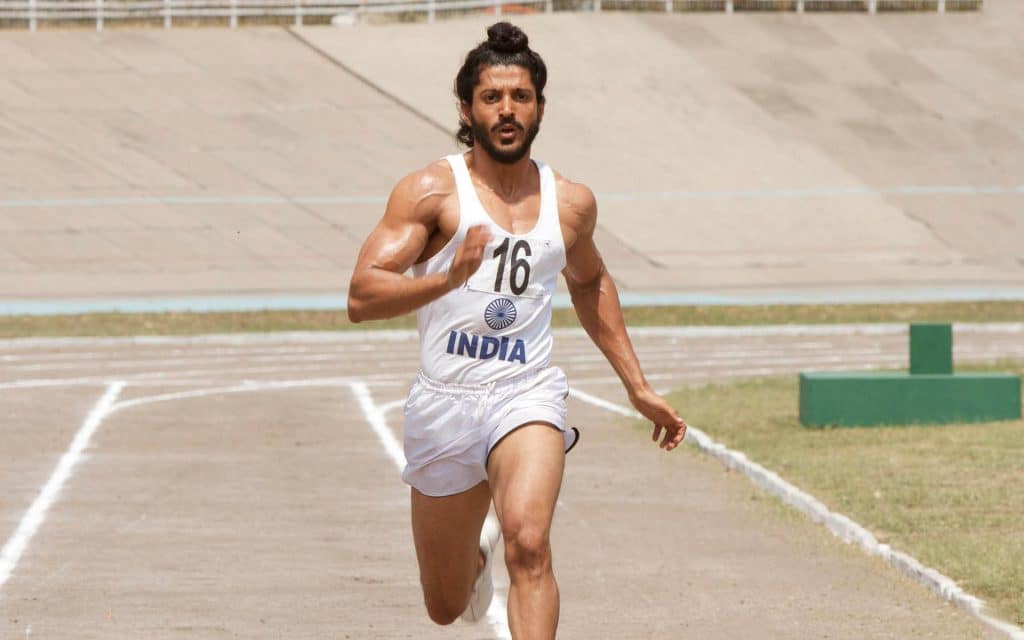If movies are a ribbon of dream, glorious, escapist fantasy designed to provide willful suspension of disbelief, then historical movies and biopics are cool. If, however, one views them as realistic, well that’s another matter.
Movies are meant to entertain and creative license — taking liberties with the facts — comes with the territory. Historical purists, on the other hand, believe that while hype, drama and exaggerating facts for effect is fine, movies should never insult, misrepresent or distort the truth or facts.
The latest Bollywood fare, Bhaag Milkha Bhaag, a glorious effort at representing the life of the Flying Sikh Milkha Singh, a runaway box office success, is a case in point as hawk-eyed critics have questioned many parts of the movie’ historical factual inaccuracies. They point out, for starters, that when Milkha Singh was released from jail in the 1950s, how come the year indicated on the form was 2013? Also, how did electronic railway signals arrive at the time, how did he manage to ride a 2012 model mobike or wear a baseball cap with a Velcro strip (which were introduced only in the 1960s) and finally how could the announcer during the climax race mention “Gaddafi Stadium” in the 1960s, when it got its name only in 1975? Are you listening, Prasoon Joshi and Rakeysh Om Prakash Mehra?
There are more bloopers from Bollywood. In Shootout at Wadala how does gangster Manya Surve (John Abraham) wear a vest band launched in 2010 when the event took place only in the 1980s? Also, in the final bang-bang, cops are armed with six shot revolvers, but no one is seen re-loading, and incidentally, more than six shots are fired.
In the Attacks of 26/11, depicting terrorists who attacked Café Leopold in 2008, the car parked outside was a model not launched until Sept 2011. In another wonderfully engaging film Kai Po Che (based on a human interest story of three friends in the backdrop of the Godhra riots) how come people are watching a news channel that was launched only a year later than the events that unfolded in 2002? Also, the car plates, five-digit train numbers and the authenticity of cell phone models are all unrealistic. In the Ajay Devgun dud Himmatwala, while the movie year indicated is 1983, a huge cut-out of Tom Cruise starrer Top Gun, released in 1986, pops up. In Special 26 Anupam Kher smartly boards a train in the WDP-4B class in the 1980s. Hello, it was introduced only in 2010!
While these bloopers and goof-ups are commonplace, should they be ignored as cinematic liberties allowed to filmmakers, whose objective is to entertain? These are not, after all, documentaries. Many of the events and happenings are yanked off the pages of history and absorbed by a generation with little knowledge, or interest, in the actual events, so what’s the big deal, argue fans of Bollywood masala. Hard-boiled critics disagree, insisting that “research is critical and sacrosanct when portraying glories of inspirational and historical vignettes of the past.”
Veteran film producer Mahesh Bhatt believes there is nothing wrong in telling filmmakers where they have goofed, because “it will caution them to do better research and homework in future,” Coming from a full-on entertainer dedicated to cleverly blending sex with songs and thrills that are audience-friendly and define new highs in sensationalism (Jism, Raaz, Murder, Aashiqui) this surely comes as a surprise.
Bollywood junkie Adesh Mehra however doesn’t give a damn about the research: “Who the hell cares about historical accuracy or factual authenticity when seeing a jhakaas masala movie? Even when you see a Jodha Akbar, the recent Bhaag Milkha Bhaag, the earlier Guru, even Attenborough’s iconic Gandhi, we seldom carry text books or are hung-up on the exact twists and turns in the narrative, right? What is critical is: did the film engage my attention in any way? Did I enjoy it? Was it entertaining, inspirational, thought-provoking, moving …? The last damn thing you worry about — unless you are one of those dull, khadoos kill-joy chasmis academic types — is the letter not the spirit because a movie is meant to be a fun experience and along the way if you are also enlightened and enriched, that’s a bonus, chief!”
Maya Luthra, a student of film studies in London, is shocked by Mehra’s argument: “The young man seems to have little knowledge and lesser respect for the criticality of the research quotient in something as powerful and impactive as movies. Admittedly, films are a medium of entertainment, but when filmmakers consciously choose to zero-in on an iconic personality from history, politics, sports or entertainment, or focus on a cataclysmic event that impacted that time, it is crucial that authenticity be factual accuracy is not sacrificed at the alter of entertainment with outrageous creative license.
“No one is suggesting that it should play out as a didactic classroom lecture, but the challenge for the filmmaker will be to blend fact with fiction in a way that is both entertaining and enriching. Sure, minor blips can be ignored, but it must be remembered that totally distorting facts to make it audience-friendly and box-office specific is not acceptable. Some things at least should remain sacred and not be for sale.”
Everything considered alas, neither research howlers nor authenticity deficit seem to play a major role in the fate of movies at the Box office. Trade Analyst Komal Nahata sums it up with chilling logic: “Hardly ten percent of the audience view movies through the prism of factual accuracy or authenticity. Their mindset and attitude borders on complete surrender to the contents played out on the screen. Irrespective of their social, intellectual or cultural status, they are united as one unit of entertainment-driven, fantasy-seekers who have large hearts and are generous to ignore and overlook factual discrepancies. It is a proven fact that the research blunders have zero effect on the box office, simply because the magical darkened theatre is not a classroom.”
